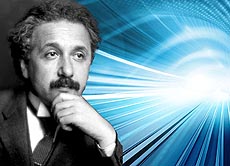Proving special relativity: episode 1
 |
| More than 100 years after Einstein penned his theory of special relativity, the Internet is full of people who question his ideas. Yet particle accelerators such as Fermilab's Tevatron and CERN's Large Hadron Collider simply wouldn't work the way they do if Einstein was wrong.
|
In 1905, Albert Einstein wrote four seminal papers. The most famous was his theory of special relativity, which describes how an object behaves as its speed increases. It predicts the most mind-bending things: Time slows down as speed goes up. Increasing speed also causes the length of an object to shrink. And, according to some science popularizations, an object's mass increases as its velocity approaches the speed of light. (This statement is both kinda-sorta right and terribly wrong — we'll get to that in a future column.) Perhaps its best-known prediction is that no object with mass can go faster than light. This last statement is especially disappointing, as it puts the kibosh on mankind's dreams of zipping around the galaxy and exploring nearby stars.
These predictions are all counterintuitive; we never see these behaviors in our everyday lives. If you're in a high-speed jet fighter, the length of objects doesn't shrink, objects themselves don't get heavier, and time seems to march along at its familiar pace.
The fact that Einstein's predictions and common sense disagree prompts a subset of science enthusiasts to react against the theory of relativity. Science bulletin boards are full of relativity deniers, some holding firmly to the ideas of the 1800s and others espousing ideas that are alternatives to special relativity.
Part of the gap between ordinary experience and Einstein's predictions originates in the velocities involved. Until you get to really fast speeds, special relativity is numerically indistinguishable from the classical physics you learn in a high school or freshman college class. In fact, the difference in physics between the two approaches is less than one percent until you get to a speed of 18,600 miles per second. That's about fast enough to get from Chicago to Honolulu in a second, and not even going the short way — that's going via London. Given that an M-16 rifle bullet barrels through the air at about half a mile per second and that the fastest projectile ever fired moves at about 10 miles per second, it is not surprising that our intuition doesn't accurately predict the behavior of matter under these super-high speeds.
Over the next three columns, we'll talk about relativity with an emphasis on how particle and accelerator physics demonstrates without any doubt that Einstein's ideas are correct. While you'll have to wait for subsequent columns to learn about some detailed evidence, I can tease you with a compelling demonstration of why scientists don't use classical physics when they design accelerators.
Let us use the venerable Fermilab Tevatron as our example. This accelerator was a ring 3.9 miles in circumference. According to relativity, the protons in the accelerator moved at 99.99995 percent the speed of light, or 186,000 miles per second.
Given these figures, relativity predicts that the protons will circle the ring about 48,000 times a second. In contrast, classical physics predicts that the velocity of protons in the Tevatron is about 46 times faster than light and therefore that a proton will orbit the ring about 2,220,000 times a second. Fermilab accelerator scientists observed the expected 48,000 times a second. Score one for relativity.
In the next column, we'll look at the energies and velocities in the various accelerators in the Fermilab complex and explore the idea of relativistic mass. Given the ability of scientists at accelerator laboratories to accelerate particles to high velocity, we are able to confront both classical and relativistic physics with real data. The message from the data is clear: Our universe obeys the laws of relativity.
—Don Lincoln
Want a phrase defined? Have a question? Email today@fnal.gov
|